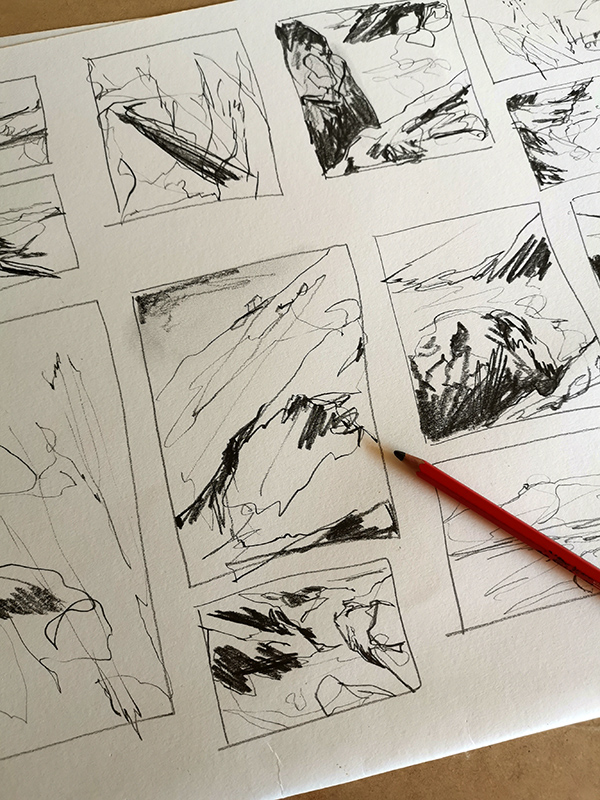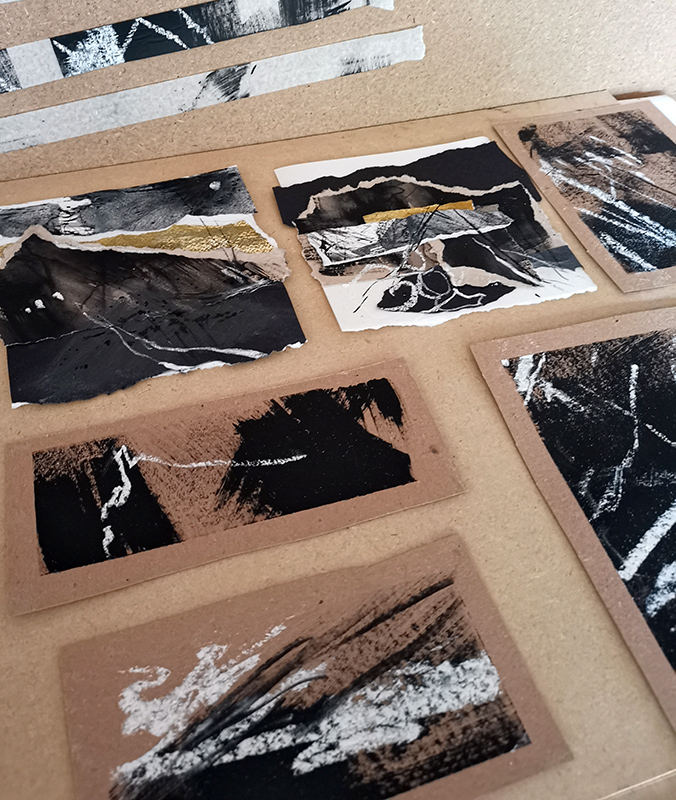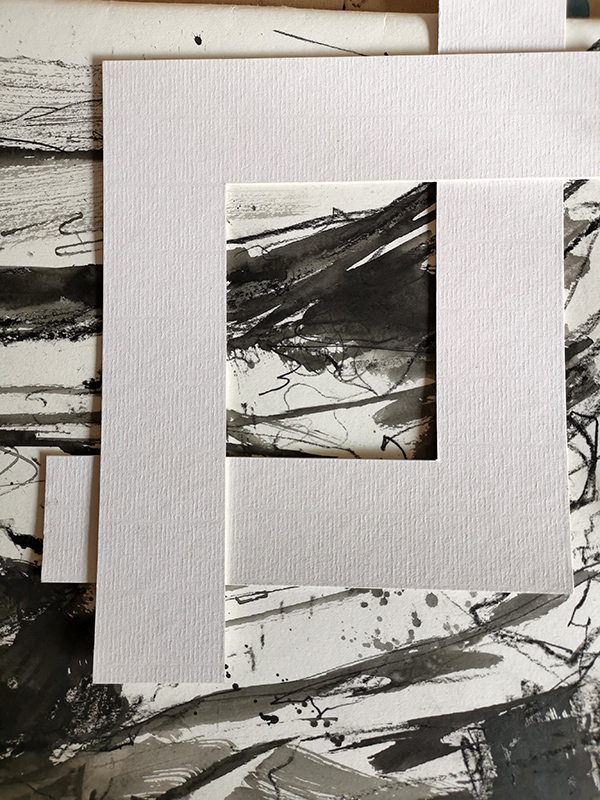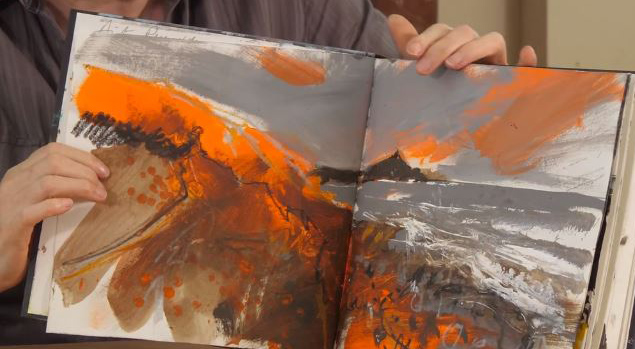I must confess, I have wanted to join one of Anita Reynold’s in-person courses for a couple of years so I am keen to experience her Abstracting the Landscape online edition.
Within moments of clicking ‘play’, I’m transported to a windswept Cornish location, with Anita warmly welcoming from the screen. Immediately, I want to leap from my chair and head for the nearest patch of wild nature, pencils and charcoal in hand, but first a little preparation is needed.
With Anita’s virtual guidance, I gather together what I will need: Tupperware is filled with pastels, felt tips and pencils, and sheets of white cartridge and buff paper are taped onto a wooden board, some dissected into grids with strips of masking tape. The buff paper is prepared with loose brush-strokes of black acrylic too; providing an intriguing base layer over which to work.
‘I think the biggest problem when you begin working outside is that you’re faced with this big, blank piece of intimidating paper,’ says Anita, as if reading my mind. ‘If you mess the paper up before you go, the less precious you are about it.’
More sheets of paper are divided into roughly-drawn frames in varying formats in portrait and landscape orientations: an invitation for quick thumbnail sketches – a form of no-pressure, visual note-taking.

I want to experience the course both at home and outdoors, but decide to begin outside. I choose a moorland spot with rocky outcrops, similar to the first video location. I set up my board against a granite rock and take a moment to orientate myself. ‘Don’t rush into plonking yourself down at the first thing that looks good,’ Anita advises. ‘Explore first, then you’ll discover viewpoints you wouldn’t have seen otherwise.’
She also highlights the importance of jotting down colours or sensory experiences before you start sketching: bright orange lichen on granite boulders; grey scudding clouds; the taste of salt in the air; or simply noting the cold and wet that your feet feel. Every description lends nuance and will be an invaluable reference when you’re back in the studio. 
I turn to the thumbnail sketches. The idea is to lay down quick, energetic responses to the landscape, spending no more than a few seconds on each frame. Over-thinking can obliterate any freshness in your mark-making. Besides, speed is of the essence if you’re working outdoors in inclement weather or in the winter months.
I move on to the gridded sheets of paper, trying not to simply focus on the clichés of the landscape. ‘I often think the tors, the sea and the tin mines steal all the focus,’ Anita says whilst capturing stands of dried gorse in her drawings: ‘we should let the quieter, less-studied things have a chance.’
I lose myself in drawing, experimenting with marks that reflect the quality and energy of what my eyes are drawn to. As Anita explains, ‘the dry gorse is scratchy and dry so this would translate into a scratchy and dry series of marks or application of paint. Smooth boulders, on the other hand, may require a slower, softer approach.’ I change the speed and weight of my marks, alternating between my dominant and non-dominant hands, trying to evoke the raw, wild landscape.


As is often the way with trying new techniques, I run into a few teething problems. My pencil leads break (I’ve left my craft knife at home); the chalk that I had carefully taped to a bamboo stick disappears into a prickly gorse bush, and I almost lose several sketches to the wind.
This is all worth it, though, when I remove the masking tape from the gridded papers and I'm rewarded with a series of disrupted drawings, each one a curious segment of place. Instantly, I was discovering entirely new accidental compositions and abstracted forms that could be developed further.
A few days later, I follow another video. This time indoors. Being warm and comfortable inside can sometimes lead to being more constrained in the way you work. To counteract this, Anita suggests working on the floor using materials taped to long sticks and setting a timer for 1-3 minutes, alternating hands and materials, so that you replicate the energy and freshness that you’d be using outside. Although watching a video isn’t the same as being out in the environment itself, when I notice the heavy rain battering the windows I’m glad to be both dry and still experimenting. I turn up the sound of the looped video so I can hear the sea pulling at the sand, rock and pebbles of Porth Ledden and can almost imagine I’m there.

As the course develops, Anita takes us through countless techniques, all of which she uses to hone and develop her own work, such as line drawings, tonal studies, memory sketches, explorations of collage and colour, creating handmade brushes and tools from nature, and even basic monoprinting using simple materials found at home. Everything we create as we go along provides the foundation for the next iteration. Through this gradual process of simplifying and abstracting, we are able to focus in on the essence of what we have experienced, which we will then enlarge on further in our paintings.
Creating ‘finished’ paintings, however, is the hard part! Anita suggests pinning up everything we’ve created, picking out the pieces that interest us the most, then sitting with those to see if there is any commonality between them. Do they evoke a feeling or a thought? Is there a motif that is being repeated? ‘That’s really what development is when you come to abstracting the landscape,’ she explains: ‘you’re adding something of yourself to the work and working out what the landscape means for you, what you’re trying to say.’

When it comes to painting, her advice is not to be constrained by an imagined outcome:
‘Just throw some paint at the canvas or paper with some energy. Get a sense of the windswept, eroded landscape and remember the playfulness, excitement and variety of those first marks you made. And, if things don’t go well, just remember that everything we produce is just a step along the way, an investigation, and the paper can always be used as material for another artwork!’
There is so much to this immensely enjoyable course you could happily dip in and out of over several months (you have access to it for a full year). Although I love the in-person courses at Newlyn School of Art for the personal feedback and encouragement – the ability to keep coming back to different elements of the course again-and-again is a huge bonus for the Online Courses. I have been stretched creatively, whilst also learning many techniques which I will definitely use in my future work. And I have to say, having Anita as your wise and friendly art companion at a click of a button is worth every penny.
- Kari Herbert